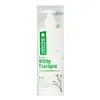What's inside
What's inside
 Key Ingredients
Key Ingredients

 Benefits
Benefits

 Concerns
Concerns

 Ingredients Side-by-side
Ingredients Side-by-side

Water
Skin ConditioningDimethicone
EmollientIsohexadecane
EmollientNiacinamide
SmoothingGlycerin
HumectantGlutathione
Sodium Hyaluronate
HumectantGlycine
BufferingCystine
MaskingSodium PCA
HumectantPetrolatum
EmollientCarbomer
Emulsion StabilisingPhenoxyethanol
PreservativeParfum
MaskingMethylparaben
PreservativeSodium Hydroxide
BufferingAcrylates/C10-30 Alkyl Acrylate Crosspolymer
Emulsion StabilisingDisodium EDTA
Titanium Dioxide
Cosmetic ColorantWater
Skin ConditioningCetearyl Nonanoate
EmollientCaprylic/Capric Triglyceride
MaskingPEG-20
HumectantGlyceryl Stearate
EmollientPropylene Glycol
HumectantButylene Glycol
HumectantCetyl Alcohol
EmollientStearyl Alcohol
EmollientTocopherol
AntioxidantHordeum Vulgare Extract
EmollientHydrolyzed Barley Protein
Skin ConditioningPotassium Palmitoyl Hydrolyzed Wheat Protein
CleansingSimmondsia Chinensis Seed Oil
EmollientParfum
MaskingLactic Acid
BufferingAscorbyl Palmitate
AntioxidantCucumis Sativus Fruit Extract
EmollientHydrolyzed Oat Protein
Skin ConditioningBisabolol
MaskingHydrolyzed Silk
HumectantVitis Vinifera Seed Oil
EmollientDipotassium Glycyrrhizate
HumectantPhenoxyethanol
PreservativeMethylparaben
PreservativeEthylparaben
PreservativeIsobutylparaben
AntimicrobialButylparaben
MaskingPropylparaben
PreservativeWater, Cetearyl Nonanoate, Caprylic/Capric Triglyceride, PEG-20, Glyceryl Stearate, Propylene Glycol, Butylene Glycol, Cetyl Alcohol, Stearyl Alcohol, Tocopherol, Hordeum Vulgare Extract, Hydrolyzed Barley Protein, Potassium Palmitoyl Hydrolyzed Wheat Protein, Simmondsia Chinensis Seed Oil, Parfum, Lactic Acid, Ascorbyl Palmitate, Cucumis Sativus Fruit Extract, Hydrolyzed Oat Protein, Bisabolol, Hydrolyzed Silk, Vitis Vinifera Seed Oil, Dipotassium Glycyrrhizate, Phenoxyethanol, Methylparaben, Ethylparaben, Isobutylparaben, Butylparaben, Propylparaben
 Reviews
Reviews

Ingredients Explained
These ingredients are found in both products.
Ingredients higher up in an ingredient list are typically present in a larger amount.
Methylparaben is a preservative and is a paraben. It is used to prevent the growth of fungus, mold, and other harmful bacteria. Parabens are chemicals used as preservatives in both cosmetics and food.
Methylparaben can be synthetically created. It can also be found naturally in some fruits, such as blueberries.
Oftentimes, Methylparaben is combined with other parabens to help increase the shelf life.
The safety of Methylparaben is currently being studied. While ongoing studies are looking into the safety of parabens, the results have been very mixed. Some studies have not found Methylparaben to be harmful.
Learn more about MethylparabenParfum is a catch-all term for an ingredient or more that is used to give a scent to products.
Also called "fragrance", this ingredient can be a blend of hundreds of chemicals or plant oils. This means every product with "fragrance" or "parfum" in the ingredients list is a different mixture.
For instance, Habanolide is a proprietary trade name for a specific aroma chemical. When used as a fragrance ingredient in cosmetics, most aroma chemicals fall under the broad labeling category of “FRAGRANCE” or “PARFUM” according to EU and US regulations.
The term 'parfum' or 'fragrance' is not regulated in many countries. In many cases, it is up to the brand to define this term.
For instance, many brands choose to label themselves as "fragrance-free" because they are not using synthetic fragrances. However, their products may still contain ingredients such as essential oils that are considered a fragrance by INCI standards.
One example is Calendula flower extract. Calendula is an essential oil that still imparts a scent or 'fragrance'.
Depending on the blend, the ingredients in the mixture can cause allergies and sensitivities on the skin. Some ingredients that are known EU allergens include linalool and citronellol.
Parfum can also be used to mask or cover an unpleasant scent.
The bottom line is: not all fragrances/parfum/ingredients are created equally. If you are worried about fragrances, we recommend taking a closer look at an ingredient. And of course, we always recommend speaking with a professional.
Learn more about ParfumPhenoxyethanol is a preservative that has germicide, antimicrobial, and aromatic properties. Studies show that phenoxyethanol can prevent microbial growth. By itself, it has a scent that is similar to that of a rose.
It's often used in formulations along with Caprylyl Glycol to preserve the shelf life of products.
Water. It's the most common cosmetic ingredient of all. You'll usually see it at the top of ingredient lists, meaning that it makes up the largest part of the product.
So why is it so popular? Water most often acts as a solvent - this means that it helps dissolve other ingredients into the formulation.
You'll also recognize water as that liquid we all need to stay alive. If you see this, drink a glass of water. Stay hydrated!
Learn more about Water